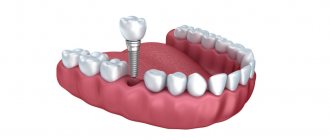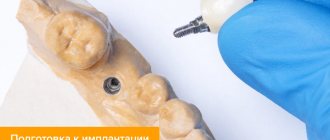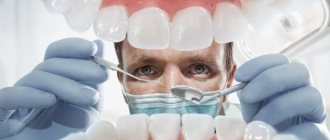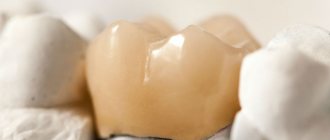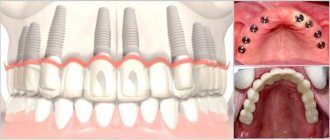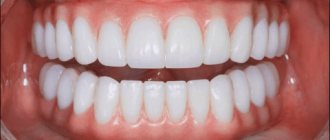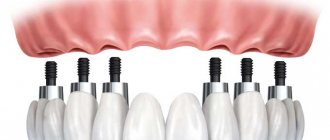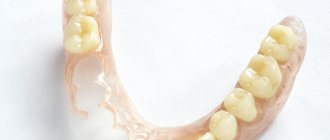- Features of dentures for the upper jaw
- Manufacturing materials
- Advantages of removable dentures for the upper jaw
- Clasp designs
- Soft dentures
- Rules for getting used to new teeth
Prosthetics of the upper jaw teeth has its own anatomical features.
In particular, there is a place to create support - the sky. There are several methods to solve the problem. Moreover, the more healthy teeth left, the more options you can use. Removable dentures for the upper jaw are so improved that they can compete with fixed ones.
The main advantages of such designs:
- Chewing function and aesthetics are completely restored;
- The structures are universal and can be installed in case of partial or complete loss of teeth;
- Creation is carried out individually, depending on the clinical picture;
- The structures are lightweight and can be used for a long time;
- Does not require much time to install;
- Adaptation happens quickly.
A complete removable denture can be permanent or temporary - intended to be worn until a permanent denture is made or implants are installed.
The average cost of installing removable dentures on the upper jaw in Moscow is from 9,000 rubles to 60,000 rubles.
Types of complete removable dentures of the upper jaw and their features
The indication for complete removable prosthetics is total edentia. This is the loss of all teeth on the jaw. If the patient has 1-3 teeth remaining, then this type of product is installed based on them. If there is not a single healthy tooth left, the dental structure is retained only by suction to the gums and mucous membrane. Modern technologies make it possible to install it on implants. The following types of dental structures are distinguished:
- acrylic;
- nylon;
- combined (acrylic gums and ceramic teeth);
- without sky;
- on implants.
Dental structures are also distinguished by the type of fixation:
- vacuum suction;
- retention of the product due to implants or micro-implants.
The correct choice of material and type of prosthesis fixation ensures comfortable wearing and a long service life.
Reasons for poor fixation
- Incorrect fit of the prosthesis initially;
- Over time, the size of the gum and jaw have changed;
- Prosthesis care violations.
In rare cases, it happens that even a fixed prosthesis begins to wobble. The reason is that the cement on which the crown was fixed may lose its strength after a few years. In this case, you should immediately contact a specialist who knows how to fix the denture without damaging it. The crown can be carefully removed and reinstalled with new cement. More often, this problem affects those who installed crowns many years ago. Modern cement for fixing the prosthesis is much more durable.
Types of dentures for the upper jaw in the absence of teeth
Let us examine in more detail the types of dental prosthetics for the upper jaw.
Acrylic. It is the most popular type of such denture structures. Pros:
- strength;
- high resistance to chewing loads;
- ease of operation;
- fast production;
- affordable price.
Many patients prefer this type of product for its realism.
Thick plastic does not show through where the artificial tooth connects to the pink base. The service life is 3-5 years. Nylon. Nylon is the softest and most flexible material. The dentist may recommend installing this type if the patient has no teeth at all or most of them have been lost. Advantages:
- high level of wear resistance and flexibility;
- does not cause allergic reactions;
- rarely break;
- in color and shape they are almost indistinguishable from real teeth;
- Nylon is softer than acrylic, so this material does not irritate or injure mucous membranes.
Despite all the advantages, such structures have a short service life - 8-12 months.
Complete prosthetics on implants. This type is recommended for installation if vacuum fixation is not possible. To securely hold the removable structure in the oral cavity, 3-4 implants are installed. In case of complete atrophy of bone tissue, microimplants (4 or more) are used.
The service life of this type of product on implants is 15-20 years. Microimplants will last only 2-3 years. After this time, the body usually begins to reject them.
Removable design without palate. Advantages:
- affordable price;
- convenience and comfort when wearing;
- a clear absence of the palate or the presence of a thin bridge;
- reliable fixation;
- uniform distribution of chewing load;
- quick addiction (almost not felt in the mouth).
Installed only if there are 4 or more healthy teeth.
Manufacturing materials
- Acrylic plastic is a fairly rigid material that ensures even distribution of chewing load and thorough chewing of food. Plastic removable dentures are the most budget option. In addition, the acrylic removable denture has a rigid base, preventing the jaw bone tissue from atrophying too quickly. One of the disadvantages is that a removable plate prosthesis with a palate will require a long period of getting used to.
- Nylon is a very flexible material. A nylon removable denture is quite comfortable and does not require a long adaptation time.
A removable partial denture is used to restore one or more teeth in a supported manner.
This can be a plate or clasp prosthesis that covers only part of the palate. Such prostheses contain:
- Arches made of dental alloys;
- Teeth made of plastic;
- Fixing elements are clasps or locking structures that provide good aesthetics.
Conditionally removable dentures, fixed on implants that act as supporting teeth, provide the most complete replacement.
Removable dentures for the upper jaw without palate
Removable dentures for the upper jaw without palate
There are 3 types:
- Bugelnye. They consist of a rigid metal base and acrylic artificial gum. Thanks to this, the chewing load is distributed evenly. The service life with careful care is 10 years. Depending on individual characteristics, the patient may be offered products with the following fasteners: hooks, locks, and telescopic crowns. In the first 2 cases, the place of fixation will be visible to others. In the latter, the supporting tooth is completely covered with a crown, so the attachment site is not visible to others.
- Removable Quattro Ti (“Quadrotti”). A soft analogue of clasp structures. This type is more comfortable. Feature: the attachment point is not visible, it has a transparent base. Service life – from 5 to 7 years.
- Sandwich dentures with attachments. This design can be used if you have 2 healthy teeth. It consists of plastic, artificial gums and dental crowns. Can last up to 5 years.
The type of prosthetics is selected by the dentist only after examining the oral cavity.
Advantages and disadvantages of removable dentures
Advantages:
- can be used even in difficult cases;
- fast production and installation;
- treatment is allowed for people of any age;
- affordable price;
- a fairly short period of adaptation;
- realistic appearance;
- After adaptation, you can eat any food.
If you think about the downsides, there are few of them. For example, such dentures require special care and regular cleaning. Their long-term use can cause bone tissue atrophy. But they are characterized by relative fragility, the average service life is 3-5 years.
How to get used to dentures?
After installing an artificial product, most people feel relief. They think that the most difficult stage has been passed and now they can enjoy a full life. But do not forget that the prosthesis is a foreign body. It can cause rejection, so you need to endure a difficult period of getting used to the new teeth. Also, some patients may experience an allergic reaction to production materials.
Common problems that arise after installation of a prosthesis:
- vomiting reflex;
- excessive salivation;
- discomfort when chewing food;
- loss of taste perception;
- speech distortion.
During the adaptation period it is recommended:
- drink more fluids to avoid dry mouth;
- in the first weeks you need to limit the consumption of solid food;
- fruits and vegetables should be eaten in small, cut pieces;
- lightly massage your gums to prevent numbness;
- strengthen gums and prevent irritation with decoctions of sage and chamomile.
If the above problems do not disappear within several weeks, and the patient feels pain or experiences other unpleasant sensations, you should consult your doctor. The product may be incorrectly manufactured and rub the mucous membrane. In this case, it will be sent for revision.
How to clean dentures at home?
In order for the prosthesis to last a long time, it is necessary to regularly and properly care for it. Doctors distinguish 3 main stages of cleaning structures of this type:
- Soaking in warm water with a special tablet for cleaning dentures (for at least 15 minutes). This manipulation will help remove deep dirt that cannot be removed with a regular brush.
- After the product has been in water for the specified period, it is necessary to clean it with a brush with soft bristles. It is prohibited to use toothpaste with abrasive components. They can scratch the denture, causing bacteria to multiply in these scratches.
- After cleaning, rinse the structure under running water
Clean the product carefully and carefully.
An accidental fall may cause it to break. To clean your dentures after eating, you can use dental floss or special rinses.
An alternative solution is implantation.
Any model of removable denture is not able to stop the process of bone tissue atrophy, which inevitably follows tooth extraction. The only option that can protect against atrophy is dental implantation, which allows you to preserve the existing volume of bone tissue. Using this technique, you can restore not only the crowns, but also the roots of the teeth, as well as the full functioning of the jaw system.
Video review from a patient about lower jaw implantation after long-term wearing of a removable denture
Prices for removable dentures
Prices for removable dentures
The cost depends on:
- number of lost teeth;
- the material used;
- type of construction;
- fastening method.
Any type of removable dentures is produced in a dental laboratory within 2 weeks. The prosthetic procedure itself will take a little longer. During the first visit, a detailed diagnosis of the oral cavity is carried out. Next, the dentist chooses a method for restoring the integrity of the dentition and makes an impression of the jaw. Once the structure is ready, the patient will be invited to the clinic for its installation and fixation.
Prosthetic prices:
- removable prosthetics – from RUB 19,450;
- nylon - from 26,100, clasp - from 47,700 rubles;
- partial removable with soft base – from RUB 29,300;
- full removable with soft base – from 29,300 rubles;
- with clasp fixation – from RUB 42,990;
- on locks/micro-locks – from 54,990 to 75,990 rubles.
The cost also depends on the choice of clinic and the qualifications of the specialist.
What are the types of removable plate dentures?
A plate prosthesis consists of a base made of polymer compounds onto which artificial crowns are attached. There are models equipped with locking elements. This type of product is made from:
- acrylic;
- polyurethane composition;
- nylon base.
The cost of the structure depends on the choice of manufacturing material.
There are 2 main types of plate dentures: complete and partial. The first one is held securely due to the suction effect. The second one is installed only if there is at least one supporting tooth. Clasps act as retaining fasteners.
What to do?
- Contact a specialist for advice and help;
- Adjust the design or order a new one;
- Find another prosthetic option.
In general, each specific case has its own individual solution. For example, if teeth are completely missing, you can use acrylic or nylon dentures. They are perfectly attached due to vacuum, sticking to the gums. A high-quality prosthesis does not require the use of special creams. However, in patients with atrophied bone tissue, when moving the jaw, air can get under the prosthesis, breaking the vacuum. In this case, two implants are placed, and the structure is held securely.
If not all teeth in the mouth are lost, but the upper denture, which is conditionally removable, does not hold, there is a solution for this too. Such designs can be plate, nylon, or clasp. They are fixed with clasps, hooks, and gingival processes. If the structure is unstable, you just need to tighten the fastening. But you can’t do it yourself, you might accidentally break it. You can only trust the work to a doctor.
Stages of manufacturing plate dentures
At the first visit, the doctor examines the oral cavity. If diseases are identified, their treatment is prescribed. Next, the dentist makes an impression of the jaws. A wax template with bite ridges is made in a dental laboratory. At the patient's next visit to the dental office, these templates are tried on to determine the correct bite height. Then a wax base is made and the teeth placement is selected. After the next fitting, the wax composition is replaced with a plastic one. At the last stage, the prosthesis is installed on the patient.
The product is manufactured within 2 weeks. During this period, a person needs to visit the clinic 3-5 times. Appointments are prescribed by the attending physician.
Full dentures with implant support
A modern treatment method for completely edentulous patients is implantation with fastening systems connecting the implants to the surface of the dentures. Today there are many types of prosthetics. When choosing a design, consider:
- the patient's wishes;
- condition of the oral cavity;
- number and location of replaced teeth.
Based on the number of implants, the following methods are distinguished:
- 2-implant (mainly used for the lower jaw);
- All-on-4 (all on four);
- All-on-6 (all on six).
Overdentures on implants restore the aesthetics of the jaw and its function. These treatment options are considered optimal for edentulous patients.
Another popular option is a fixed bridge prosthesis. This product is intended to replace several missing units (3-4). Two of them are replaced with implants, and a bridge is installed on the rest.
A beam prosthesis on implants is in demand for complete edentia. When installed, 4 to 8 implants are placed in the oral cavity. The prosthetic structure is secured using locks. This type allows you to evenly distribute the load on both the product and the bone tissue.
How is prosthetics performed on implants?
- Initial consultation with a dentist, examination of the oral cavity, choice of implantation technique.
- Determination of indications and contraindications. Purpose of CT scan of the jaw.
- Preparing the oral cavity for surgery. Removal of unnecessary roots, treatment of caries, gingivitis, periodontal disease and other diseases. Carrying out professional cleaning of the oral cavity. The patient may be prescribed bone grafting (on an individual basis).
- Implants and a surgical protocol are selected.
- Computer simulation of the procedure is carried out.
- Carrying out the operation itself. Installation of abutments and temporary prostheses. Possible bone tissue augmentation.
- After the implants have healed, a permanent prosthesis is installed. Before making it, the doctor takes an impression of the jaw and it is made from pre-selected materials using a computer model.
After installation, the dentist gives advice on proper oral care. For example, you need to brush your teeth (implants and dentures) 2 times a day. Particular attention should be paid to the part adjacent to the gum, thoroughly cleaning it of plaque. If during the healing period discomfort and bleeding do not disappear, you should consult a doctor.
The cost of prosthetics on implants (the full complex, from examination to installation of the prosthesis) is 1,132,880 rubles. It will take 7 months to complete the course of treatment.
In any case, you cannot determine on your own which treatment method is right for you. This can only be done by a qualified dentist - after examining the oral cavity and based on the tests taken. Under no circumstances should treatment be put on hold. After all, if prosthetics are not carried out immediately after tooth loss, this can lead to prolapse of soft tissues and bone atrophy.
Calculator: calculate prices online
Prosthetics, All-in-4 All-in-4
Calculate the full cost of manufacturing a prosthesis on implants yourself; installation of implants is calculated separately.
Select the type of prosthesis
0
Specify the required number of prostheses
Better and more accurate - in a free consultation! All addresses and telephone numbers are on the website chudostom.ru. Make an appointment by calling the branch closest to you.
The calculation is not a public offer; the final cost is determined at a free consultation BEFORE the start and does not change during the treatment process.
Total cost rub.
0
How to manage without dentures?
Alas, you cannot do without prosthetics. The loss of even one tooth disrupts the harmony in the oral cavity. In place of a lost tooth, the skin becomes less elastic, the correct oval of the face is lost over time, and signs of aging appear. The load on the remaining teeth increases. The jaw bone becomes thinner and the gum structure changes.
After tooth extraction, less blood flows into this area of tissue, and the number of blood vessels in the area where the tooth is missing decreases. As a result, the structure of the jaw bone is disrupted. All these processes then lead to displacement of the dentition, to an incorrect bite. And this, in turn, affects the quality of chewing food and disrupts the digestion process.
Even a person’s speech is impaired. Due to the absence of individual teeth, it is impossible to pronounce some sounds correctly. Especially if the problem affects the front teeth. Moreover, the absence of the front row of teeth leads to changes in the nasolabial fold. It lengthens, the corners of the mouth droop, and the person begins to look older than his age.
